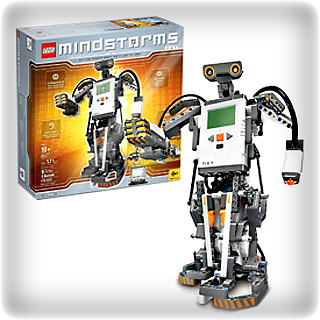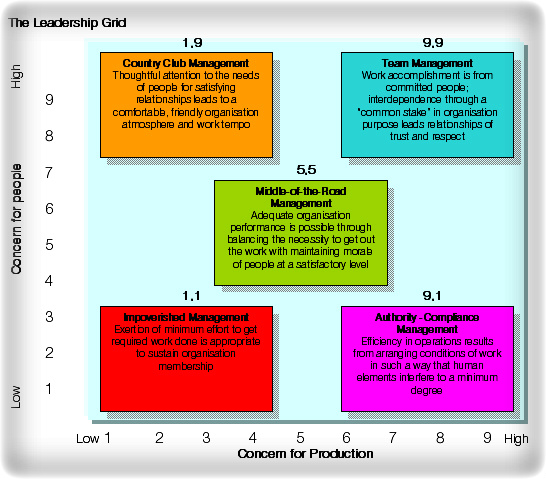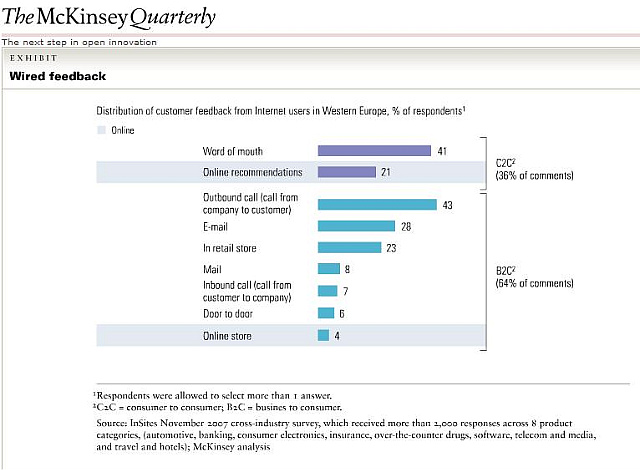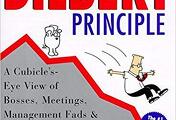
개방형 혁신의 핵심 함께 창조하기(Cocreation)
혁신 (innovation)은 최근 경영계에서 가장 중요하게 생각하는 핵심 경쟁력을 확보하는 거의 유일한 방법이며 이를 이끌어내는 리더십에 대한 중요성이 크게 증가하고 있습니다. [아래 맥킨지 보고서 참조]
과거에 실험실과 연구소 그리고 기업단위별로 배타적이었던 것에서 탈피하여, 최근 혁신은 보다 분산된 조직/사람들간의 협력과 공동연구개발을 통해 만들어지고 있고 이를 일컬어 개방형 혁신 (Open Innovation)이라고 말합니다.
예를 들어, 위의 그림에 있는 LEGO 의 Mindstorm 이라는 교육용 로봇 시스템은 미국 MIT Media Lab. 과 함께 개발되어 만들어 진 것입니다. 다양한 USB 확장으로 Mp3, 컴퓨터, 외부기기 들과의 Interface를 통해 학생들이 장난감처럼 가지고 놀면서 동시에 다양한 기계,전기,전자 및 다양한 과학기술에 대한 관심을 증가시키고 교육효과를 이끌어내고 있습니다. LEGO 사는 과거의 정적인 장난감 블럭 생산과 더불어 이러한 동적 메카니즘이 가능한 보다 고급형 장난감을 만들고 Online 으로 다양한 사용사례를 공유토록 하여 어린 학생 뿐 아니라 수많은 대학생과 성인들을 위한 교육 컨텐츠 사업을 확장해 나가고 새로운 Market 을 열어가는 혁신을 만들어 냈습니다.
Part Number: L29-8527
Price: $249.99
Weight: 8.00 lbs
Lego is back at it again after dropping off the face of the robotics universe for a bit. The new set offers modern interfaces (USB, Bluetooth) and a new set of sensors including an ultrasonic ranger, a sound sensor, a light sensor, and touch sensor along with 3 servo motors. There is also a pile (577 pieces) of parts you can use to create your own robots, copy machines, or rubix cube solving machines.
만약 LEGO라는 회사가 자사의 연구인력과 종업원들만으로 이러한 것을 만들어 내고자 했다면 아마도 실패했을 겁니다. 왜냐하면 제한된 정보와 다양한 아이디어 그리고 무엇보다도 소비자에 대한 이해가 적을 수 밖에 없었을 테니까요. 하지만, LEGO는 과감하게 자신들 스스로 고개를 숙이고 외부 협력 조직과 사람들에게 협력과 협조를 부탁하였고, 사람들은 기꺼이 자신들이 가진 창의적 아이디어를 LEGO와 함께 나누고 발전시켜 나갔던 것입니다. 그래서 회사 뿐 아니라 사회 전체적으로 새로운 혁신적인 아이디어와 제품을 통해 과거에는 없었던 "가치"를 만들어 내고 서로 Win-Win 할 수 있었습니다.
그럼 이러한 개방형 혁신을 이끌어 내는 리더십은 어떤 것이어야 할까요?

Bale & Mouton의 Leadership 스타일 연구에 따르면 "사람에 대한 고려" 와 "생산에 대한 고려" 를 축으로 하여 다섯가지 리더십 스타일이 있다고 합니다.
1. 권위주의 리더십 [Authority-Compliance (9,1)]
- 생산과 과제에 중심을 두고 사람에 대한 고려와 소통은 무시함
2. 컨트리 클럽 매니저 리더십 [Country Club Management (1,9)]
- 일 보다는 사람에 대한 고려만을 하며 늘 분위기가 좋도록 하는데만 관심있음
3. 방임형 리더십 [Impoverished management (1, 1)]
- 일도 사람도 고려하지 않고 오직 자신의 위치에만 관심있음
4. 중간자 리더십 [Middle-of-the-Road management]
- 일과 사람에 대한 고려를 적당히 하면서 양쪽을 중재하여 갈등을 적게하는데 관심있음
5. 팀 리더십 [Team management (9, 9)]
- 명확한 일에 대한 목표를 가지고, 사람들의 협력과 관계개선에 힘써 참여와 소통을 이끌어냄
이러한 리더십 스타일에 무엇이 옳고 그름은 없습니다. 각각 처해진 상황에 따라 필요한 리더십은 다르니까요. 하지만, 혁신을 위한 리더십은 분명 "사람에 대한 고려" 와 "일에 대한 고려" 가 모두 높은 팀 리더십 스타일이 이나 컨트리 클럽 매니저 스타일이보다 효과적이지 않을까합니다.
왜냐하면, 창의적 아이디어는 기본적으로 "사고의 자유" 로 부터 나오게 되는데, 일 중심으로 과제와 계획에 너무 집중하게 되면 새로운 생각과 시도는 나오기 어렵고 더불어 협력을 이끌어 내기도 어렵기 때문입니다. 더불어 일방적으로 "일"을 시키는 권위주의 적인 리더십이 아니라 협력과 소통을 중요시하는 민주적 리더십이 "개방형 혁신"을 유도하고 성공으로 이끌어 낼 수 있기 때문입니다.
독일 민요 중에, "Die gedanken sind frei = 생각하는 것은 자유다" 라는 것이 있습니다. 12세기 초 시작된 독일 민요이고 19세기 독일 혁명과 20세기 나치에 반대하는 백장미 운동시에 많이 불리고 금지곡까지 되었던 노래인데, 인류 보편적 기본권이 "생각의 자유" 에 대해 노래하고 있습니다.
다시 21세기 새로운 시대를 맞이하여 치열한 시장 경쟁을 펼치고 있는 이때에, 아주 기본적 인권인 "사고의 자유"와 민주주의가 더더욱 중요해 지고 이를 실현해 낼 수 있는 통합적이고 민주적 "리더십" 을 바탕으로 함께 창조하기 (Co-creation)이 절실해 지고 있다는 것이 아이러니 입니다.
"생각은 자유다 - Die gedanken sind fre: 독일 혁명 가요"
독일어 노랫말:
Die Gedanken sind frei, wer kann sie erraten,
sie fliehen vorbei wie
nächtliche Schatten.
Kein Mensch kann sie wissen, kein Jäger
erschießen
mit Pulver und Blei: Die Gedanken sind frei!
Ich denke was
ich will und was mich beglücket,
doch alles in der Still', und wie es sich
schicket.
Mein Wunsch, mein Begehren kann niemand verwehren,
es bleibet
dabei: Die Gedanken sind frei!
Und sperrt man mich ein im finsteren
Kerker,
das alles sind rein vergebliche Werke.
Denn meine Gedanken
zerreißen die Schranken
und Mauern entzwei, die Gedanken sind
frei!
Drum will ich auf immer den Sorgen entsagen
und will mich auch
nimmer mit Grillen mehr plagen.
Man kann ja im Herzen stets lachen und
scherzen
und denken dabei: Die Gedanken sind frei!
Ich liebe den Wein,
mein Mädchen vor allen,
sie tut mir allein am besten gefallen.
Ich bin
nicht alleine bei meinem Glas Weine,
mein Mädchen dabei: Die Gedanken sind
frei!
영어 번역 노랫말:
Thoughts are free, who can ever guess them?
They just flee by like nocturnal shadows.
No man can know them, no hunter can shoot them,
with powder and lead: Thoughts are free!
I think what I want, and what makes me happy,
but always discreetly, and as it is suitable.
My wish and desire, no one can deny me
and so it will always be: Thoughts are free!
And if I am thrown into the darkest dungeon,
all this would be futile work,
because my thoughts tear all gates
and walls apart. Thoughts are free!
So I will renounce my sorrows forever,
and never again will torture myself with some fancy ideas.
In one's heart, one can always laugh and joke
and think at the same time: Thoughts are free!
I love wine, and my girl even more,
Only I like her best of all.
I'm not alone with my glass of wine,
my girl is with me: Thoughts are free!
The next step in open innovation
The creation of knowledge, products, and services by online communities of companies and consumers is still in its earliest stages. Who knows where it will lead?
Jacques Bughin, Michael Chui, and Brad Johnson
June 2008
For most companies, innovation is a proprietary activity conducted largely inside the organization in a series of closely managed steps. Over the last decade, however, a few consumer product, fashion, and technology businesses have been opening up the product-development process to new ideas hatched outside their walls—from suppliers, independent inventors, and university labs.
Executives in a number of companies are now considering the next step in this trend toward more open innovation.1 For one thing, they are looking at ways to delegate more of the management of innovation to networks of suppliers and independent specialists that interact with each other to cocreate products and services. They also hope to get their customers into the act. If a company could use technology to link these outsiders into its development projects, could it come up with better ideas for new products and develop those ideas more quickly and cheaply than it can today? Suppose that a wireless carrier, say, were to orchestrate the design of a new generation of mobile devices through an open network of interested customers, software engineers, and component suppliers, all working interactively with one another.
This is the model of innovation as a convergence of like-minded parties. Increasing numbers of organizations are now taking that approach: distributed cocreation, to use its technical name. LEGO, for instance, famously invited customers to suggest new models interactively and then financially rewarded the people whose ideas proved marketable. The shirt retailer Threadless sells merchandise online—and now in a physical store, in Chicago—that is designed interactively with the company’s customer base. In the software sector, open-source platforms developed through distributed cocreation, such as the “LAMP” stack (for Linux, Apache, MySQL, and PHP/Perl/Python), have become standard components of the IT infrastructure at many corporations. What facilitates this new approach to innovation is the rise of the Web as a participatory platform. What will drive its adoption by an increasing number of companies is the growing competitive need to uncover many more good ideas for products and to make better and faster use of those ideas.
Distributed cocreation is too new for us to draw definitive conclusions about whether and how companies should implement it. But our research into these online communities and our work with a number of open-innovation pioneers show that it isn’t too soon for senior executives to start seriously examining the possibilities for distributed cocreation or to identify the challenges, such as the ownership of intellectual property and increased operational risk, they face in adopting it.
The new face of innovation
In nearly every sector, many of the ideas and technologies that generate products emerge from a number of participants in the value chain. Boeing designs its aircraft, but suppliers make (and own the intellectual property for) many of the components. Likewise, HP’s computers and Apple’s iPod include hundreds of parts invented and manufactured by companies in more than two dozen countries. In many sectors, suppliers understand the technology and manufacturability of their pieces of the end product better than the OEMs do. Eli Lilly licenses and sells products that other companies develop; high-technology and media giants continually scan the horizon for innovations developed by start-ups and try to acquire whatever seems promising.
The benefits of specialization and collaboration seem obvious today. Clearly, an automaker’s suppliers can make better headlights at lower cost than the OEM can, because specialization promotes focus and innovation. Many companies participate in joint ventures for individual products or marketing packages and collaborate with university labs or specialists. Businesses are increasingly open to insights and ideas gleaned from any source—especially their customers, through call centers, retail data, and focus groups. Collaboration extends in many directions: when companies pursue a new product, many of them consult with contract specialists and suppliers and test prototypes with their customers.
But collaboration looks very different on Wikipedia, the online encyclopedia that represents a true phenomenon on the Internet. Wikipedia is created entirely by its users, not by a corporate-development staff in California. It is a living and continually expanding global reference work, which has expanded in less than seven years to offer more than six million articles in over 250 languages.2
The example of Wikipedia suggests that companies can take even greater advantage of specialization by ceding more control over decisions about the content of products to networks of participants (suppliers, customers, or both) who interact with one another. Does this seem far-fetched? IBM apparently doesn’t think so: it has adopted the open operating system Linux for some of its computer products and systems, drawing on a core code base that is continually improved and enhanced by a massive global community of software developers, only a small fraction of whom work for IBM. In software, open-source packages are gaining such favor that they are cutting into profit margins and drawing market share from proprietary software brands.
Many other examples of cocreation are now under way. One of them, participatory marketing, which encourages customers to help create marketing campaigns, is sometimes more than just a new tactic to attract attention. Approached in the right way, it is also an opportunity to start cocreating products with them. Last year, for instance, Peugeot invited people to submit car designs online and attracted four million page views on its site. The company built a demonstration model of the winning design to exhibit at automotive marketing events and partnered with software developers to get it included in a video game. Even business-to-business companies are starting to cocreate with customers: corporate users of SugarCRM’s customer-relationship-management software customize it to meet the specific needs of their industries.
Companies have three ways to win by adopting distributed cocreation. First, they can capture value from the cocreated product or service itself, as LEGO and Threadless have, by merchandising good ideas gleaned from the network. (In South Korea, the cocreated cosmetic brand Missha has seized a 40 percent market share in its segment.) Second, companies can capture value by providing a complementary product or service. Red Hat, for instance, sells a host of technology services to users of Linux. Third, they can benefit indirectly from the cocreation process—for example, through an enhanced brand or strategic position.
Hurdles ahead
While distributed cocreation does seem promising, it isn’t entirely clear what capabilities companies will need (or how they will organize those capabilities) to make the most of it. Many of the answers will become clear as companies gain greater experience with various open-innovation approaches, including distributed cocreation. But a few challenges are already apparent.
Attracting and motivating cocreators
Since companies must provide the right incentives to the right participants, they should understand what talented contributors find valuable about interacting with a community. Financial incentives may be necessary in some instances, but other participants can be inspired to cocreate by mechanisms like community recognition. Companies will also have to spot hurdles to participation—such as the ease or difficulty of contributing and the time needed to do so—and take steps to minimize any problems. In addition, they may need to implement well-structured paths to coax participants to move from lower to higher levels of participation. Wikipedia, for instance, now has 500 participating administrators who have earned special privileges to prevent edits on certain articles, usually to stop vandals who have targeted them.
Structuring problems for participation
To make it possible for many contributors to participate effectively in a cocreation community, problems should be broken down to let contributors work in parallel on different pieces. Otherwise, it will be impossible for a critical mass of participants to cocreate effectively. A global team of more than 2,000 scientists, for example, participated in the design of the ATLAS particle detector, a complex scientific instrument that will be used to detect and measure subatomic particles in high-energy physics. The effort was disaggregated into many different components and distributed across 165 working groups, which used Internet-based tools to help coordinate the work.3
Governance mechanisms to facilitate cocreation
Communities are productive when they have clear rules, clear leadership, and transparent processes for setting goals and resolving conflicts among members. Sun Microsystems, for instance, developed its Solaris operating system, cocreated with a global community of software developers, in the early 1990s. The company established a board, including two Sun employees and a third member from the larger software community, charged with loosely overseeing the project’s progress. Even then, by the way, the community wanted Sun to relinquish more control.
The leadership must also maintain a cohesive vision, since there is always a risk that community members will “fork” intellectual property and use it to develop their own cocreated product or service. Mozilla, the online application suite distributed by the Mozilla Foundation, was cocreated by a software community.4 As the programs were being developed, two contributing engineers, dissatisfied with the project’s direction, used the Mozilla code to create the Firefox Web browser. Community leaders eventually made it the primary supported browser.
Maintaining quality
Many cocreating online communities assume that “crowds”5 know more than individuals do and can therefore create better products; as the open-source-software expert Eric S. Raymond has said, “Given enough eyeballs, all bugs are shallow.”6 It is far too early to know with certainty if this idea holds true across all kinds of products, but a growing consensus maintains that in software development, at least, distributed cocreation is a ticket to quality. A study published in the European Journal of Information Systems in 2000, for instance, noted that “open-source software often attains quality that outperforms commercial proprietary” approaches.7 What’s more, a December 2005 study published in the scientific journal Nature concluded that Wikipedia’s entries on scientific subjects were generally as accurate as those in the Encyclopædia Britannica.8 Still, some have questioned these conclusions and the accuracy or insights of the entries on which they were based.
A number of cocreated products have crossed a quality threshold to become widely adopted. A survey by Netcraft, an Internet research firm, showed that the cocreated open-source Web-server program Apache runs more than half of all Web sites and that eight of the ten most reliable Internet hosting companies run Linux. While the general thesis that cocreated products are higher in quality is difficult to prove, companies are increasingly willing to rely on them for mission-critical business processes.
Lessons from communities
Although it is still too early to develop useful frameworks for success with cocreation, they will no doubt emerge over the next few years. Meanwhile, some lessons about how to proceed are coming out of both the consumer and the professional online communities.
Participative media supply some of these lessons. Our research suggests that 25 percent of Western Europe’s Internet users now post comments and reviews about consumer products of all kinds (exhibit). User-generated media sites are growing in numbers of visitors and participants by 100 percent a year, traditional sites by perhaps 20 to 30 percent.

These numbers suggest that people are more and more willing to participate with companies online and that companies can tap into that willingness today. To give an example, in the online environment Second Life, where participants assume three-dimensional likenesses called avatars and interact digitally with each other, approximately one participant in ten is cocreating with companies—for example, testing prototypes or helping to design new products and services. We expect that percentage to rise. At present, Second Life has few brands (virtual destinations, within the site, created by companies well known in the offline world), and participants generally don’t know how to interact with them. In fact, during our recent research on the behavior of Second Life participants, we found that only four in ten members know about the possibility of cocreating with their favorite brands. When they do become aware of this, 60 percent of them say they would be willing to experiment with cocreation.
Research that we and others have conducted on consumers participating in online communities demonstrates that most cocreators recognize that the brand—not they—will own the resulting intellectual property. Why then do they get involved? Rewards and fame were certainly motivators, but participants are largely interested in making a contribution and seeing it become a reality. An important factor we’ve found in our Second Life study is the extent to which participants are willing to trust brands. In choosing between competing ones, brand affinity is the most important factor for users willing to cocreate, and 40 percent of would-be cocreators will refuse to cocreate with companies they don’t like or trust.9
Our research also suggests that companies will need a combination of incentives to encourage consumer participation. In a recent analysis of user-generated video sites,10 we found that participants had various nonfinancial motives, such as fame, fun, and altruism. This insight has been confirmed by the Second Life research, which found that only one-third of the users who cocreate with brands do so for a financial reward. Furthermore, people who seek to increase their online fame often expend considerable effort enlisting others to join their networks in hopes of increasing the size of the audience, thereby helping to create a larger pool of participants for cocreation itself. One key seems to be attracting participants with as many kinds of motives as possible, so that they reinforce each other. Of course, incentives might have to evolve if cocreation reached the limits of individual “volunteerism.” Communities could, for instance, start paying participants for their contributions or actively promote their reputations outside the community—say, in marketing campaigns.
In professional online communities, trust and affinity are important. At the Myelin Repair Foundation (MRF), for example, scientists from five universities have accepted a complex IP-sharing agreement that will let MRF retain the rights to license discoveries to pharmaceutical companies. This novel medical-research model is based on cocreation among a closed group of researchers who aim to develop a drug that will treat multiple sclerosis (MS) by promoting the repair of myelin, the coating surrounding the nerve fibers that MS affects. MRF hopes to complete its work within five years—75 percent faster than the time required by current research models—and half of the royalties will be put back into the foundation to finance future projects. Since the researchers started work, in 2004, they have identified ten targets and three therapeutic candidates, developed 11 tools to study Myelin, and published nearly 20 scientific articles.
Cocreation through evolution
Companies do not have to reconceive their business systems to start experimenting with distributed cocreation. In many cases, the first step is to identify where it may already have spouted within the company. At LEGO, for example, the executive team recognized the possibilities in part because of the success of a product launched in 1998: Mindstorms, programmable bricks originally developed as an educational tool through a partnership with the MIT Media Lab. A remarkable community of Mindstorms enthusiasts—adults as well as children—embraced the product and began to share designs online. This success prompted LEGO’s executives to consider how the company could use its online LEGO Gallery to harness the creative efforts of customers to develop ideas or products in its main toy-brick business.
Companies have other ways as well to experiment with cocreation by using existing systems or resources. When the telecom operator BT decided to allow third-party software developers to create applications for BT’s network (a variant approach to cocreation), it could take advantage of the fact that its internal software developers were already familiar with the practices of open-source software and were designing standardized Web interfaces for many of its existing business applications.
Even the most advanced businesses are just taking the first
few steps on a long path toward distributed cocreation. Companies should
experiment with this new approach to learn both how to use it successfully and
more about its long-term significance. Pioneers may have ideas about
opportunities to capture value from distributed cocreation, but fresh ones will
appear. To benefit from them, companies should be flexible about all aspects of
these experiments. ![]()
About the Authors
Jacques Bughin is a director in McKinsey’s Brussels office, Michael Chui is a consultant in the San Francisco office, and Brad Johnson is a principal in the Silicon Valley office.
The authors wish to thank their McKinsey colleagues Markus Löffler, James Manyika, Nathan Marston, Andy Miller, and Roger Roberts for their contributions to this article.
Notes
1A number of books and articles discuss how companies are adopting open innovation. Four particularly useful sources are C. K. Prahalad and M. S. Krishnan, The New Age of Innovation: Driving Co-created Value through Global Networks, McGraw-Hill, 2008; Henry Chesbrough, Open Innovation: The New Imperative for Creating and Profiting from Technology, Boston: Harvard Business School Press, 2003; Henry Chesbrough, Open Business Models: How to Thrive in the New Innovation Landscape, Boston: Harvard Business School Press, 2006; and Eric von Hippel, Democratizing Innovation, Cambridge, MA: MIT Press, 2005.
2The English-language version recently passed two million articles, compared with only 120,000 for the Encyclopædia Britannica.
3We researched the design project in collaboration with the Oxford Internet Institute. For more information, see Philipp Tuertscher, “The ATLAS Collaboration: A Distributed Problem-Solving Network in Big Science,” http://www.oii.ox.ac.uk, 2007.
4See Lenny T. Mendonca and Robert Sutton, “Succeeding at open-source innovation: An interview with Mozilla’s Mitchell Baker,” mckinseyquarterly.com, January 2008.
5See Renée Dye, “The promise of prediction markets: A roundtable,” mckinseyquarterly.com, April 2008.
6Eric S. Raymond, The Cathedral & the Bazaar: Musings on Linux and Open Source by an Accidental Revolutionary, Sebastopol, CA: O’Reilly, 1999.
7Jan Ljungberg, “Open source movements as a model for organising,” European Journal of Information Systems, 2000, Volume 9, Number 4, pp. 208–16.
8Jim Giles, “Internet encyclopaedias go head to head,” Nature, 2005, Volume 438, Number 7070, pp. 900–1.
9Paul Alpar and Steffen Blaschke, Web 2.0 – Eine empirische Bestandsaufnahme, Wiesbaden, Germany: Vieweg+Teubner, 2008.
10Jacques R. Bughin, “How companies can make the most of user-generated content,” mckinseyquarterly.com, August 2007.
source: http://www.mckinseyquarterly.com/Information_Technology/Networking/next_step_in_open_innovation_2155
'Meditation on Korean Leadership > 1.Leadership Anecdote' 카테고리의 다른 글
| 무능할 수록 승진한다? (딜버트 법칙) (4) | 2008.07.28 |
|---|---|
| 무엇이 인재를 죽이는가? (3) | 2008.07.27 |
| 진정한 리더는 모두를 만족(滿足)하게 한다...!! (0) | 2008.07.24 |
| 숨은 곧 소통, 생명, 그리고 영혼이다 (숨쉬기를 통한 리더십 개발)...!! (0) | 2008.07.22 |
| 우리에게 진정한 리더가 없는 이유: 소인배 승승장구론 (5) | 2008.07.21 |



댓글